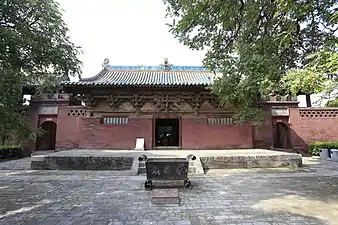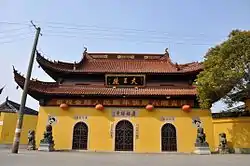Hall of Four Heavenly Kings
The Hall of Four Heavenly Kings or Four Heavenly Kings Hall (Chinese: 天王殿; pinyin: Tiānwángdiàn), referred to as Hall of Heavenly Kings, is the first important hall inside a shanmen (mount gate) in Chinese Buddhist temples and is named due to the Four Heavenly Kings statues enshrined in the hall.[1]
| Hall of Four Heavenly Kings | |||||||
|---|---|---|---|---|---|---|---|
 | |||||||
| Chinese name | |||||||
| Traditional Chinese | 天王殿 | ||||||
| Simplified Chinese | 天王殿 | ||||||
| Literal meaning | Hall of Four Heavenly Kings | ||||||
| |||||||
| Korean name | |||||||
| Hangul | 천왕문 | ||||||
| Hanja | 天王門 | ||||||
| Literal meaning | Gate of the Heavenly Kings | ||||||

Maitreya Buddha is enshrined in the Hall of Heavenly King and at the back of his statue is a statue of Skanda Bodhisattva facing the northern Mahavira Hall. In Buddhism, the Maitreya Buddha, also the future Buddha is Sakyamuni's successor. In the history of Chinese Buddhism, Maitreya Buddha has the handsome image in which he wears a coronet on his head and yingluo (瓔珞) on his body and his hands pose in mudras. According to Song-dynasty Biographies of Eminent Monks (《宋高僧傳》; Sung kao-seng chuan), in the Later Liang Dynasty (907-923), there was a fat and big-stomached monk named "Qici" (契此和尚) in Fenghua of Mingzhou (now Zhejiang). Carrying a sack on his shoulder, he always begged in the markets and streets, laughing. So local people called him "The Sack Monk" (布袋和尚). When he reached his Parinirvana, he left a Buddhist Gatha: "Maitreya, the true Maitreya, has thousands of hundreds of millions of manifestations, often instructing people of their time, even when they themselves do not recognize him." (彌勒真彌勒,分身百千億,時時示世人,世人總不識。) So he was seen as the manifestation of Maitreya Buddha. Since then, in Chinese Buddhist temples, Maitreya statues were shaped into a big fat monk's image with a big head and ears, laughing with his upper body exposed and cross-legged.
The Skanda Bodhisattva behind him is the Dharmapalass of Buddhist temples. As with Maitreya Buddha, the Skanda Bodhisattva's image has changed into that of a handsome ancient Chinese general who wore armors, and held a vajra in hand.
Four Heavenly Kings' statues are enshrined in the left and right side of the Four Heavenly Kings Hall. There are the eastern Dhṛtarāṣṭra (持國天王; Dhṛtarāṣṭra wears white clothes and armor and has a pipa, a Chinese plucked string musical instrument, in his hand), the southern Virūḍhaka (增長天王; Virūḍhaka wears blue clothes with a sword in his hand), the western Virūpākṣa (廣目天王; Virūpākṣa wears red clothes with a dragon or a snake wrapped around his arm), and the northern Vaiśravaṇa (多聞天王; Vaiśravaṇa wears green clothes with a precious umbrella in his right hand and a silver sacred mouse in his left hand). The Four Heavenly Kings are said to live in Mount Meru and their task is to protect the world in their direction respectively.[2][3]
References
- Zi Yan (2012-08-01). Famous Temples in China. Beijing: Time Publishing and Media Co., Ltd. pp. 27–28. ISBN 978-7-5461-3146-7.
- Wei Ran (2012-06-01). Buddhist Buildings. Beijing: China Architecture & Building Press. ISBN 9787112142880.
- Han Xin (2006-04-01). Well-Known Temples of China. Shanghai: The Eastern Publishing Co. Ltd. ISBN 7506024772.